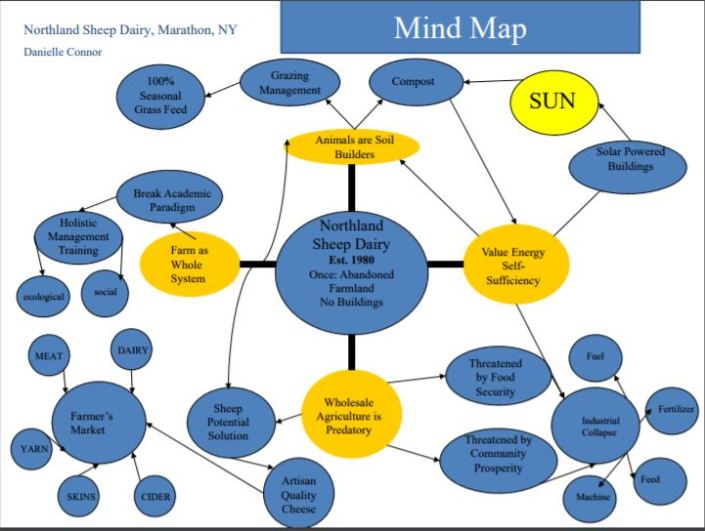Systems Thinking Tools: the mind map
 My last blog, Learning to Think Like a Mountain, introduced “systems thinking” as a useful means of understanding why “linear thinking” is inadequate when a problem under study: 1) is complex; 2) involves multiple relationships; and/or 3) involves human decision-making and uncertainty.
My last blog, Learning to Think Like a Mountain, introduced “systems thinking” as a useful means of understanding why “linear thinking” is inadequate when a problem under study: 1) is complex; 2) involves multiple relationships; and/or 3) involves human decision-making and uncertainty.
This post introduces one of the simplest and most useful of all the systems thinking tools, the mind map. There are many variations of this tool, including concept mapping and spider diagramming but they are all generally used to view multiple, complex (non-linear) relationships in a system. One of the failures of industrial agriculture is the assumption that it functions as a machine, with inputs (seeds, sun, fertilizer) that flow into a farm and outputs (food, fiber) flowing out.
 This simple, linear understanding (which Annie Leonard described so well in the popular video The Story of Stuff) is inadequate as we work toward an agroecological frame for agricultural sustainability. The mechanistic, linear view will rarely account for questions about environmental justice, decay of soil health, offsite impacts of pesticides, or vitality of rural communities, which may be discounted as “externalities.” These perspectives, will on the other hand, be considered using systems thinking.
This simple, linear understanding (which Annie Leonard described so well in the popular video The Story of Stuff) is inadequate as we work toward an agroecological frame for agricultural sustainability. The mechanistic, linear view will rarely account for questions about environmental justice, decay of soil health, offsite impacts of pesticides, or vitality of rural communities, which may be discounted as “externalities.” These perspectives, will on the other hand, be considered using systems thinking.
The mind map is also a nice tool for telling a story, such as how a household designed on permaculture (or ecological) principles is likely to view a “cup of tea.”
Instructions
Some suggestions on how to get started are:
- Start in the center with a description of the topic or theme
- Write whatever comes to mind next as a “sub-topic” and draw a connecting line, do it again, and again….
- Use images and symbols as much as possible
- Select key words and print clearly
- Each word/image should sit on its own line or inside its own bubble
- The lines should be connected, starting from the central image. Important connections between concepts in different sub-section should be indicated
- Use colors to code for key ideas or sub-systems (sections of the map)
- Use thicker lines to indicate more important connections
- Put the most important ideas are near the center (its a hierarchy of ideas)
- Do it your own way!
Using Mind Maps in Agricultural Systems
Mind maps are useful tools for beginning to understand a complex system (like a farm). Here are a few examples:

Mind maps are particularly useful for:
- understanding complex problems
- taking notes
- initial stages of designing a project
- team collaboration
- creative expression
- presenting complex material in a concise format
- team building or synergy creating activity
There are lot of mind mapping software packages available, but I find the best way to learn to do this is drawing by hand. Here is an example of a hand drawn mind map on a local project, Grow Food Northampton.
 Mind maps are particularly useful for describing a farm because they are complex systems with multiple relationships managed by humans. There is no “right or wrong” way to do this. Whatever works is fine.
Mind maps are particularly useful for describing a farm because they are complex systems with multiple relationships managed by humans. There is no “right or wrong” way to do this. Whatever works is fine.
Why not give it a try?
============================================================================

July 2, 2012 at 10:45 am
This was great, John. I’ve used FreeMind a few times and it’s pretty user-friendly, but like you said the best way is really drawing it out. That mind map about mind maps was really clear and helpful – it should be a resource available to everyone trying to solve any problem really… The next step is of course creating a solutions mind map, to the problem that is visible in the original one. Thank you for sharing!
LikeLike
July 28, 2012 at 9:18 pm
[…] Systems Thinking Tools: the Mind Map presented one of the simplest and most useful tools to help you get started. […]
LikeLike
November 23, 2017 at 1:09 pm
[…] Systems Thinking Tools: the Mind Map presented one of the simplest and most useful tools to help you get started. […]
LikeLike